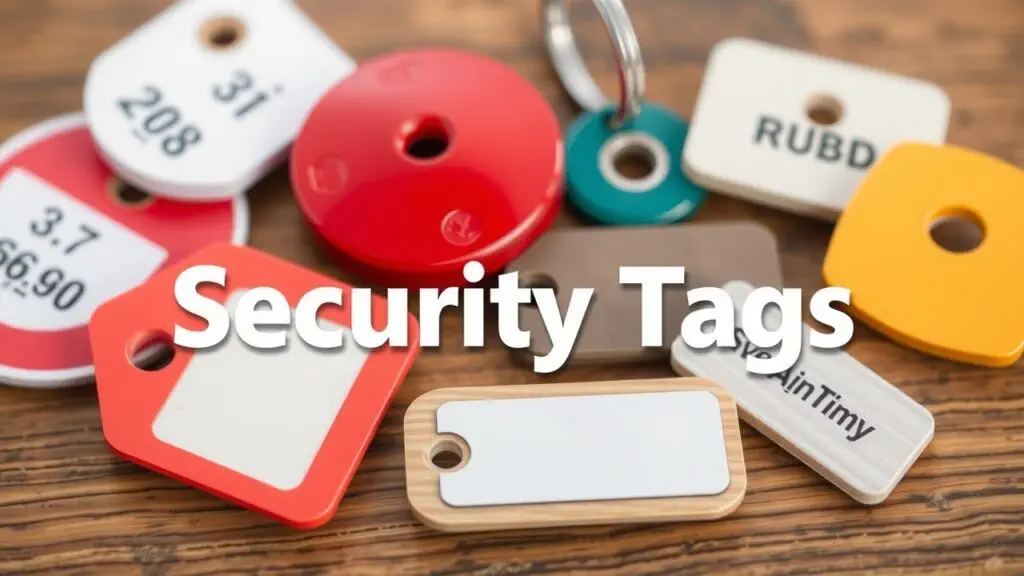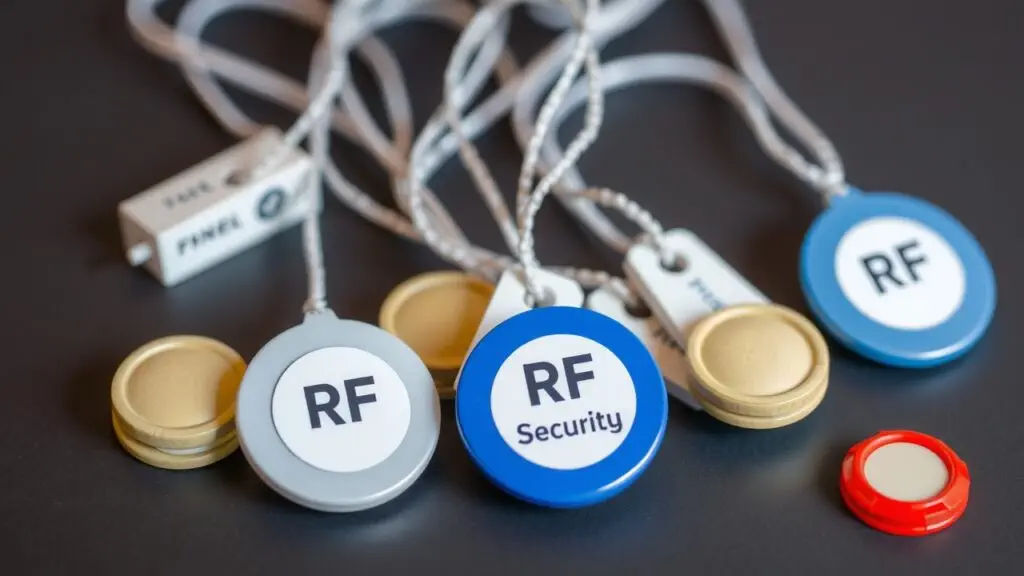Learn about different types of security tags, including hard tags, soft tags, and RFID options, to improve inventory control and reduce shoplifting.
What Are Security Tags and Why Are They Important?

Security tags are tools used in stores to stop shoplifting. They attach to items and set off alarms when someone tries to leave the store without taking them off. These tags help keep stores safe by making it hard for thieves to steal without getting caught.
Shoplifting hurts businesses a lot. Retailers lose billions of dollars every year because of theft. This loss can lead to higher prices for customers or cuts in services, which is not good for anyone. Using security tags can really help reduce these losses. Many studies show that stores with electronic article surveillance (EAS) systems see fewer thefts.
EAS systems are the main way security tags work today. They usually have three parts: security tags on products, detection antennas at exits, and devices to turn off the tags at checkout counters. If a tagged item goes through an antenna without being turned off, an alarm sounds. This alerts staff and discourages thieves.
To sum up, security tags are important for protecting retail goods from theft. They also help keep prices down for customers by reducing overall losses.
Types of Shoplifting Prevention Tags at a Glance
Here are the main types of shoplifting prevention tags you might find in stores:
- Acousto-Magnetic (AM) Tags: Use sound waves and magnetic fields to detect theft.
- Radio Frequency (RF) Tags: Rely on radio waves; often cheaper than AM tags.
- Electromagnetic (EM) Tags: Work with electromagnetic fields; they are usually larger but effective.
- RFID Tags: Radio-Frequency Identification tags allow tracking beyond just stopping theft.
- Optical Security Tags: Show visual signs if someone tries to tamper with or remove them.
Choosing the right tag depends on what you’re selling and what the store needs. For example, clothing may need different tags than electronics or other products.
Knowing about these types helps store owners use smart retail loss prevention strategies that fit their specific needs while protecting against theft effectively.
Acousto-Magnetic (AM) Tags Explained
Acousto-magnetic (AM) tags are widely used in retail security systems to prevent theft and protect items. These tags use magnetic-acoustic field technology, which mixes magnetism and sound waves to create a solid defense against shoplifting. AM tags are either hard tags or soft tags. Hard AM tags are great for larger products like clothes and electronics, while soft AM labels work well for smaller items like cosmetics and accessories.
How Do Acousto-Magnetic (AM) Security Tags Work?
AM security tags have a simple but effective way of working. Each tag has a small metal strip inside that vibrates at certain frequencies when it meets an electromagnetic field. This field is made by detection antennas set up at the exits of stores. If a tagged item passes through these antennas without being deactivated—usually done at checkout—the vibrating frequency sets off an alarm. This alert lets store staff know that someone might be trying to steal something. The system is reliable because it can tell the difference between active and inactive signals, meaning only unauthorized removals trigger alarms.
Benefits and Drawbacks of Using AM Security Tags
One big benefit of acousto-magnetic (AM) security tags is their cost-effectiveness compared to other retail security options. They provide strong protection against theft without costing too much money for retailers wanting to stop losses. Another plus is the discreet designs of AM tags, which can easily fit in with clothing or smaller items without standing out to customers.
On the flip side, there are some drawbacks to consider when using AM security systems. A notable issue is their sensitivity to strong magnets that may be found in some devices; this can deactivate the tag temporarily or even permanently if mishandled. While these tags are generally good at preventing theft, no system can guarantee full protection from all types of shoplifting.
Best Use Cases for Acousto-Magnetic Tags in Retail Settings
Acousto-magnetic (AM) tags shine in specific retail settings where valuable items need protection without making the shopping experience awkward for customers. Clothing stores often see great benefits from using these security measures because clothes face high risks during busy shopping times when shoppers might get distracted easily. Small-item retailers, like those selling jewelry or electronics, also find value in AM tagging solutions since they serve as effective yet subtle deterrents against thieves looking to target valuable items on display.
Radio Frequency (RF) Security Tag Insights
Radio Frequency (RF) security tags are widely used in retail to help stop theft. They use radio frequency technology to catch items that leave the store without being paid for. There are two main types of RF tags: hard labels and soft adhesive options. Each type serves different needs based on what the store sells and how it is laid out.
What Are RF Security Tags?
RF security tags work by using radio frequency-based detection systems. These systems connect to electronic article surveillance (EAS) setups at the store’s exits. If a tagged item tries to leave without being deactivated, it sets off an alarm.
Key features include:
- Hard Labels: These are tough plastic tags mainly used on clothes and high-value items. They are very good at preventing theft but need special tools for removal.
- Soft Adhesive Options: These are flexible stickers you can put on packages or product surfaces like cosmetics or electronics. They look less noticeable but still keep items safe.
Both types function well with EAS systems, giving great coverage in many stores.
Pros & Cons Associated With Radio Frequency-Based Systems
Using RF security tags has its ups and downs:
Pros:
- Reliable Detection Over Medium-Range Distances: RF systems can spot tagged items from up to 3 feet away, making them great for busy stores.
- Cost-Effective Solution: Compared to other technologies like RFID, RF tags usually cost less and are easier to set up.
Cons:
- Bulkier Visual Appearance: Hard labels might stand out more than softer options, which can be a downside for some products.
- Limited Range in Some Environments: While they work well most of the time, things like metal fixtures or interference from other electronics can affect how well they detect.
Knowing these pros and cons helps stores pick the right loss prevention tools that fit their needs.
Ideal Examples Matching Electronically Specific Store Layout Large Sizes Clothing Example Scenarios
In large clothing shops where there’s plenty of space and visibility matters, using hard label RF security tags can be very helpful. Here are some examples:
- High-Traffic Areas: In busy spots where customers often handle items, like fitting rooms, hard labels help ensure that any theft triggers a fast alert.
- Large Size Displays: For larger sizes shown clearly on racks, using visible hard labels not only helps deter thieves but also reminds shoppers about the store’s policies on handling merchandise.
By placing these merchandise security tags smartly throughout the store layout, retailers can protect products while still engaging customers with attractive displays that fit modern retail trends.
Understanding Electromagnetic (EM) Tags
Electromagnetic (EM) tags play a key role in retail security solutions. They help prevent theft and protect merchandise. These EAS security tags work by using electromagnetic field technology to spot unauthorized removals from the store.
How EM Tags Work?
EM technology creates an electromagnetic field around tagged items. When you attach a hard tag or soft tag to a product, it interacts with this field at exits in a store. The system has several parts:
- EM tags
- Detection antennas at the exits
- Deactivation devices at checkout
A big benefit of EM tags is their resistance to magnetic deactivation methods that shoplifters often use. This feature makes them very useful in high-security places where stopping theft is essential.
EM Tag Variations and Use Cases
There are different types of EAS systems that use EM technology, such as hard tags for clothing and soft labels for smaller items like cosmetics or electronics.
- Hard Tags: These are tough and better for high-value products.
- Soft Labels: These can be easily put on packaging without changing its look.
Various industries benefit from these anti-theft devices. For example, clothing stores find them effective against shoplifting tactics that use magnets. Stores selling luxury items often use hard EM tags for extra protection against advanced theft techniques.
Comparing EM Tags to RF and AM Tags
When we look at different security tags—like electromagnetic (EM), radio frequency (RF), and acousto-magnetic (AM)—we see some important differences.
| Feature | EM Tags | RF Tags | AM Tags |
|---|---|---|---|
| Detection Range | Moderate | Shorter | Longer |
| Cost-Effectiveness | Generally higher | Lower | Moderate |
| Resistance to Deactivation | High | Moderate | High |
All three types aim to stop theft effectively, but each has unique traits that make them fit for certain retail needs. Knowing these differences helps retailers choose the best security tag for their products and loss prevention plans.
Exploring RFID Tags for Advanced Inventory Control
RFID (Radio Frequency Identification) tags are gaining popularity in retail security solutions. These electronic article surveillance tags help track products and stop theft effectively. By learning how RFID technology works, its different types, and the pros and cons, store owners can make smart choices about using these anti-theft devices.
How RFID Tags Work?
There are two main types of RFID tags: passive and active. Passive RFID tags don’t have their own power source. They get energy from an RFID reader to send data back. When a passive tag is close enough to the reader’s radio waves, it uses that energy to transmit the information stored on its chip. This setup makes them cheaper but limits their range to just a few feet.
On the other hand, active RFID tags come with their own battery. This lets them send signals over much longer distances—up to hundreds of meters! This feature allows for real-time tracking in bigger spaces like warehouses or large stores.
The way data is stored also varies between these types. Passive tags usually hold less data than active ones because they are smaller and lack onboard power. Yet both types enable quick access to vital product info that helps enhance theft prevention techniques through improved monitoring.
RFID Tag Variations and Ideal Applications
There are several kinds of RFID tags based on their frequency ranges:
- High-Frequency Security Tags: Operate at 13.56 MHz; often used in libraries and ticketing.
- Low-Frequency Security Tags: Operate at 125 kHz – 134 kHz; typically used for animal tracking or access control.
- Ultra-High Frequency Security Tags: Work at 860 – 960 MHz; great for retail inventory management and supply chain logistics.
- Reusable Security Tags: Vary in frequency; good for long-term asset tracking.
- Disposable Security Tags: Also vary; ideal for single-use applications like clothing.
These variations let businesses choose the right type based on their needs, such as tracking high-value items or using advanced loss prevention strategies effectively.
Advantages and Disadvantages of RFID Tags
Using RFID technology has many benefits. These include better detection accuracy compared to older electronic article surveillance (EAS) systems, along with improved inventory management efficiency. Retailers get real-time views of stock levels across different locations, which helps reduce theft while making restocking easier.
However, some drawbacks need attention before starting an RFID system. The initial costs for setting up a solid system—like buying readers and software—can be higher than other EAS methods such as AM or RF systems. Additionally, some retailers might face privacy concerns from customers about data collection linked to these technologies.
In summary, understanding the various types of security tags is key for developing effective loss prevention strategies in today’s retail world. Knowing how each type functions will help business owners make informed choices that fit their specific needs.
Optical Tags: Specialized Solutions for Delicate Merchandise
Optical tags are special security labels meant for delicate items like clothing and electronics. They use smart technology to help prevent theft while keeping products safe from damage. Retailers like optical tags because they provide a good mix of protection and product care.
How Optical Tags Work?
Optical detection systems are key to how these merchandise security tags function. When an item with an optical tag goes through a store’s exit point, light sensors pick up the tag. If the tag hasn’t been deactivated or removed at checkout, it sets off an alarm, alerting staff to possible theft. This is part of electronic article surveillance (EAS) systems that help stores keep track of their inventory.
Types of Optical Tags and Suitable Applications
Different types of optical tags work for various needs:
- Removable Security Tags: These can be easily taken off by cashiers during checkout but stay on until then.
- Tamper-Evident Labels: These show clear signs if someone tries to take them off without permission; they’re great for high-value items.
- Specialized Solutions for Delicate Merchandise: Some optical tags are designed to protect sensitive items like silk clothes or fragile electronics.
This variety helps retailers choose the right solution based on what they sell.
Advantages and Disadvantages of Optical Tags
Optical tags have unique strengths and some weaknesses when compared to other anti-theft devices:
- Strengths:
- They have a low chance of damaging products when attached or removed.
- They effectively stop theft without bothering customers.
- Weaknesses:
- They might need special tools for setting up and monitoring.
- They can cost more than traditional magnetic or RFID options due to their advanced tech.
Knowing these pros and cons helps businesses create effective retail loss prevention strategies while ensuring delicate merchandise stays safe from theft without high costs or damages.
Choosing the Right Security Tag: A Comprehensive Comparison

When picking security tags for your store, it’s super important to know the different types available. The right choice can really help reduce theft and keep things running smoothly.
Key Factors to Consider
- merchandise value
- size
- material
- store layout
- budget
- existing systems
Here are some things to think about when choosing a security tag:
- Merchandise Value: If you sell expensive items, you might need advanced tagging solutions like RFID or EM tags to prevent theft.
- Size and Material: The size and type of material for your products also matter. Bigger or heavier items might need strong hard tags while smaller ones may be fine with soft tags.
- Store Layout: Know how your store is set up. Some tags work better in tight spaces, while others fit larger areas.
- Budget Constraints: Look at the upfront costs as well as ongoing costs like maintenance and deactivation.
- Existing Systems: Check if the new tags can work with what you already have in place.
Detailed Comparison
| Feature | Hard Tags | Soft Tags |
|---|---|---|
| Cost | Higher upfront cost | Lower upfront cost |
| Durability | More durable | Less durable |
| Detection Range | Longer detection range | Shorter detection range |
| Suitability | Best for high-value items | Suitable for clothing |
| Ease of Deactivation | Needs special tools | Easily deactivated at checkout |
This table helps you compare different types of security tags based on important features.
Matching Tags to Products and Integration with Existing Systems
Choosing the right security tag isn’t just about matching it to products. You also need it to fit well with your current inventory management and alarm systems:
- Look for high-theft areas, like clothing or electronics, that might need special tagging like AM or RF technology.
- Make sure the selected tags work with your existing Electronic Article Surveillance (EAS) setup by getting proper EAS system installation.
- Train staff on where to place these tags based on the product’s needs while keeping the store looking nice.
By putting all these parts together—tag choice and system integration—you can boost your loss prevention efforts and improve efficiency in your business!
Best Practices
Best Practices for Tag Placement and Attachment
Effective security tag placement is key to preventing theft. Attach tags in spots that are hard for thieves to reach. For example, place them inside clothing seams or on the underside of electronics. This makes it difficult for shoplifters to remove the tags, while still keeping them visible during store hours.
It’s also important to have a consistent method for attaching tags across different products. Retailers should use standard procedures for tagging. This way, every staff member knows how to do it right. For instance, using the same type of fastener can help avoid mistakes.
To make this clearer, include diagrams showing good tag locations on items like clothing and gadgets. These images can be great tools during staff training.
Deactivation Procedures, Regular Maintenance, and Staff Training
Properly deactivating security tags at checkout is vital. If not done right, it can cause false alarms that annoy customers and disrupt sales. Retailers need clear procedures using tag deactivators at point-of-sale stations. This helps ensure all items leave the store with their tags disabled.
Regular checks on Electronic Article Surveillance (EAS) systems are also crucial for effective theft prevention. Store owners should schedule inspections to make sure everything works well—this includes checking exit sensors and alarm responses.
Training programs must cover how to respond to alarms properly so employees know what to do when an alarm goes off unexpectedly. This preparation helps create a safe shopping space and gives staff knowledge about theft prevention methods.
Frequently Asked Questions about Security Tags
What types of security tags are available for retail?
Retailers can choose from various security tags. Common options include acousto-magnetic (AM) tags, radio frequency (RF) tags, electromagnetic (EM) tags, and RFID tags. Each type has its own features and benefits.
How do I choose the right security tag for my business?
Select a security tag based on product type and value. Consider your store layout and existing systems. Evaluate your budget and the specific theft risks you face.
How effective are different security tag systems at preventing theft?
Different systems offer varying levels of effectiveness. RFID systems provide enhanced tracking capabilities. AM and RF tags are reliable for general retail theft prevention. EM tags resist common deactivation methods.
What are detachable and non-removable security tags?
Detachable tags allow easy removal at checkout. Non-removable tags stay attached until a staff member uses a special tool to remove them. Both types serve different product protection needs.
What is source tagging?
Source tagging involves attaching security tags directly during manufacturing. This method streamlines inventory control and enhances product protection from the start.
How do I deactivate a security tag after purchase?
Staff can deactivate a security tag at checkout using special tag deactivators. Proper procedures prevent false alarms when customers leave the store.
What is the cost of various types of security tags?
Costs vary based on technology type and supplier. RFID tags typically have higher upfront costs than RF or AM tags but may offer long-term savings through better inventory management.
What are tamper-evident labels?
Tamper-evident labels show visible signs if someone tries to remove or alter them. They add an extra layer of protection for high-value items in retail settings.
How do optical security tags differ from other types?
Optical security tags rely on light sensors to detect unauthorized removal. They provide discreet protection without damaging products, unlike some traditional hard or soft tags.
Additional Insights on Security Tags
Enhancing Retail Security Measures
- Utilize multiple types: Combine different tag technologies for improved coverage.
- Train staff: Provide regular training on tag placement and removal techniques.
- Conduct audits: Regularly audit your EAS system to ensure optimal performance.
- Monitor trends: Stay updated on new technologies that enhance retail theft prevention.
- Evaluate vendor options: Research suppliers to find quality products at competitive prices.
- Implement return policies: Enforce strict return policies to deter shoplifting behaviors.
- Leverage data analytics: Use sales data to identify high-theft items and tailor strategies accordingly.
- Promote visibility: Ensure that valuable items are in well-monitored areas of the store.
Related Topics
- types of shoplifting prevention tags
- types of RFID tags
- types of optical tags
- types of security tags for retail



Types of Security Tags: A Guide to Hard Tags, Soft Tags, and RFID